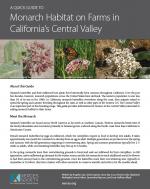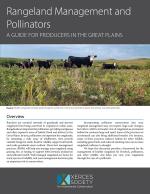As a science-based organization, the Xerces Society produces dozens of publications annually, all of which employ the best available research to guide effective conservation efforts. Our publications range from guidelines for land managers, to brochures offering overviews of key concepts related to invertebrate conservation, from books about supporting pollinators in farmland, to region-specific plant lists. We hope that whatever you are seeking—whether it's guidance on making a home or community garden pollinator-friendly, advice on developing a local pesticide reduction strategy, or detailed information on restoring habitat—you will find it here!
Find Publications
Use the search functions to sort by publication type (books, guidelines, fact sheets, etc.), location, and/or subject (agriculture, gardens, pollinators, pesticides, etc.).
The western monarch population is now less than 1% of its size in the 1980s, and urgent action is needed to stabilize their numbers. Here's how farmers can help.
Monarch Butterfly Nectar Plant Lists for Conservation Plantings is a helpful tool for ecological restoration, providing lists of plants known to support monarch adults and caterpillars.
A Guide for Producers in the Great Plains
Rangelands are important for pollinators, providing contiguous and often expansive areas of habitat (food and shelter) in the Great Plains. These best management practices (BMPs) will help you manage your rangeland using grazing, fire, or haying, to support both livestock production and pollinator health.
Opportunities abound in cities, towns, and campuses to support bees, butterflies, and other wildlife. Many outdoor spaces—from parks and school grounds to roadsides and business campuses—can provide valuable pollinator habitat. Along with new habitat, pollinators need protection from pesticides. Thoughtful pest management efforts work to reduce pesticide use and mitigate risks when pesticides are used. Such efforts can enhance the value of pollinator habitat and serve communities, offering a variety of benefits such as keeping children safe and protecting water quality.
The Xerces Society for Invertebrate Conservation, Groundswell Coastal Ecology, California Department of Parks and Recreation, and the U.S. Fish and Wildlife Service have developed a western monarch butterfly overwintering site management plan that also serves as a template for land managers at other overwintering sites.
Based on the best available data for when and where monarchs breed in the West, we have developed regionally appropriate monarch breeding habitat management windows, when management activities are least likely to have negative effects on monarchs.
Restoring monarch habitat, including roadsides, is important to the species’ recovery. A diversity of milkweed species is found on roadsides, on which readily monarchs lay their eggs, but roadsides provide more than just milkweed. They can also provide diverse nectar sources to feed adult monarchs and other pollinators. This guide highlights best management practices to reduce the impacts of herbicides on monarchs.
In California, climate change is expected to cause higher temperatures, more frequent and longer heat waves, and increased drought frequency and severity. Extreme weather events will also become more common. These challenges posed by climate change are extensive, but there ways you can increase climate resilience for pollinators in your yard, neighborhood park, or whole community.
You can take several actions to alleviate the effects of climate change on pollinators. This fact sheet provides an overview of strategies to reduce the impacts of drought, increased temperatures, and frequent heat waves in agricultural lands. Although this fact sheet is centered on California, many lessons are more broadly applicable, and can provide a useful jumping-off point for climate-smart habitat planning for other regions.
Given the many ways that climate change is likely to impact pollinators and plant-pollinator interactions, we propose multiple strategies to increase climate resilience for pollinators in natural areas. Although this fact sheet is centered on California, many lessons are more broadly applicable, and can provide a useful jumping-off point for climate-smart habitat planning for other regions.









